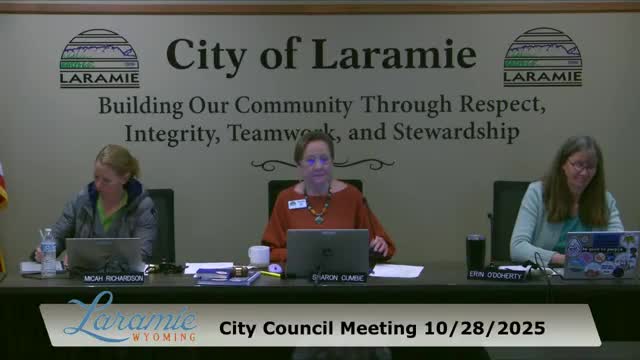City staff reviews landfill reuse-store models and plans waste-characterization study to set diversion goals
October 29, 2025 | Laramie City Council, Laramie City, Albany County, Wyoming
This article was created by AI summarizing key points discussed. AI makes mistakes, so for full details and context, please refer to the video of the full meeting. Please report any errors so we can fix them. Report an error »

Director Webb of the Solid Waste Division reviewed reuse-store and diversion models co‑located with transfer stations and landfills, and described how those programs operate, potential partners, and state-level incentives that can support diversion. Webb said local examples in Wyoming (Sheridan and Glenrock) operate at low cost with differing staffing models and that many successful programs were originally supported by state grants or nonprofit partnerships.
Webb outlined practical examples: small on-site “landfill malls” that accept household furniture and bulky items for a modest fee or free giveaway; reuse stores that operate limited hours and rely on nonprofit or private thrift‑store partners; and household‑hazardous‑waste reuse areas that can redistribute unopened or lightly used paints and cleaners rather than tracking them into hazardous‑waste disposal. Webb said some reuse models sell bulked paint for a low price and that other programs contract with local nonprofits to staff operations.
On the city’s broader waste strategy, Webb explained the need for a waste‑characterization study: randomly sampling incoming loads, sorting and weighing material types, and producing a baseline to guide targeted diversion programs and policy (for example, if cardboard is a large share of loads, the city can do targeted education). He said the city has contracted with TriHydro to scope a study and plans to complete field work before university students leave for summer; results would inform a comprehensive waste‑reduction strategy in 2026. Webb provided 2024 diversion numbers: single‑stream recycling 1,246 tons, compost 790 tons and glass 66 tons.
Council members asked about landfill gas and energy recovery, ordinance coverage for multifamily recycling, volunteer or nonprofit staffing options, and ways to use capped landfill areas for renewable energy. Webb and staff said local landfill gas generation is minimal and not currently sufficient for energy projects; multifamily properties have different service requirements under local ordinance; and community partners (conservation corps, nonprofits) are potential staffing sources. No formal actions or votes were recorded; staff will proceed with the characterization study and return with data and recommended, achievable diversion goals.
Webb outlined practical examples: small on-site “landfill malls” that accept household furniture and bulky items for a modest fee or free giveaway; reuse stores that operate limited hours and rely on nonprofit or private thrift‑store partners; and household‑hazardous‑waste reuse areas that can redistribute unopened or lightly used paints and cleaners rather than tracking them into hazardous‑waste disposal. Webb said some reuse models sell bulked paint for a low price and that other programs contract with local nonprofits to staff operations.
On the city’s broader waste strategy, Webb explained the need for a waste‑characterization study: randomly sampling incoming loads, sorting and weighing material types, and producing a baseline to guide targeted diversion programs and policy (for example, if cardboard is a large share of loads, the city can do targeted education). He said the city has contracted with TriHydro to scope a study and plans to complete field work before university students leave for summer; results would inform a comprehensive waste‑reduction strategy in 2026. Webb provided 2024 diversion numbers: single‑stream recycling 1,246 tons, compost 790 tons and glass 66 tons.
Council members asked about landfill gas and energy recovery, ordinance coverage for multifamily recycling, volunteer or nonprofit staffing options, and ways to use capped landfill areas for renewable energy. Webb and staff said local landfill gas generation is minimal and not currently sufficient for energy projects; multifamily properties have different service requirements under local ordinance; and community partners (conservation corps, nonprofits) are potential staffing sources. No formal actions or votes were recorded; staff will proceed with the characterization study and return with data and recommended, achievable diversion goals.
View the Full Meeting & All Its Details
This article offers just a summary. Unlock complete video, transcripts, and insights as a Founder Member.
✓
Watch full, unedited meeting videos
✓
Search every word spoken in unlimited transcripts
✓
AI summaries & real-time alerts (all government levels)
✓
Permanent access to expanding government content
30-day money-back guarantee
